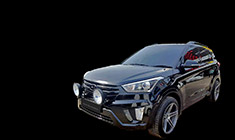News
Hyundai Creta N-Line vs its rivals: Which fast crossover would you buy
It competes with cars like the 2023 Kia Seltos, VW Taigun, Skoda Kushaq and Mahindra XUV700.
BHPian Ripcord09 recently shared this with other enthusiasts.

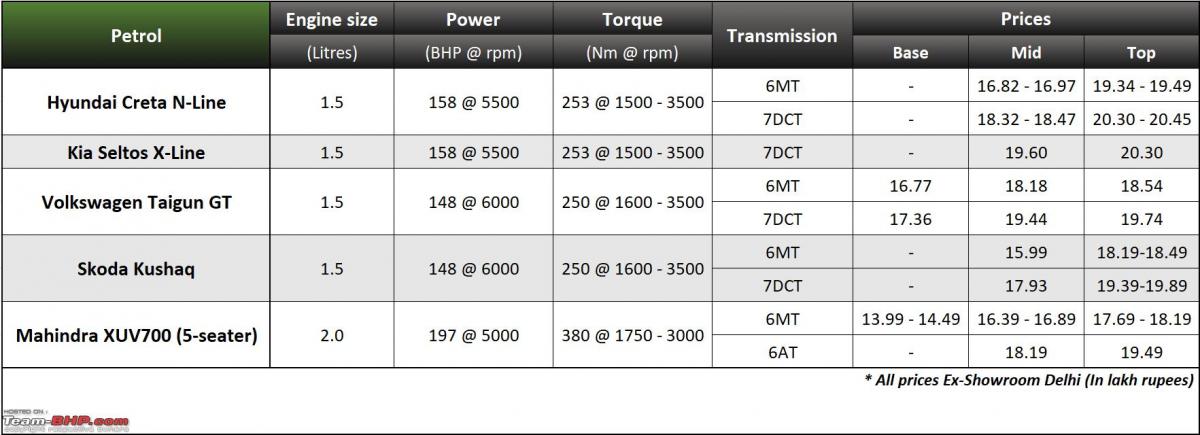
Hyundai Creta N-Line
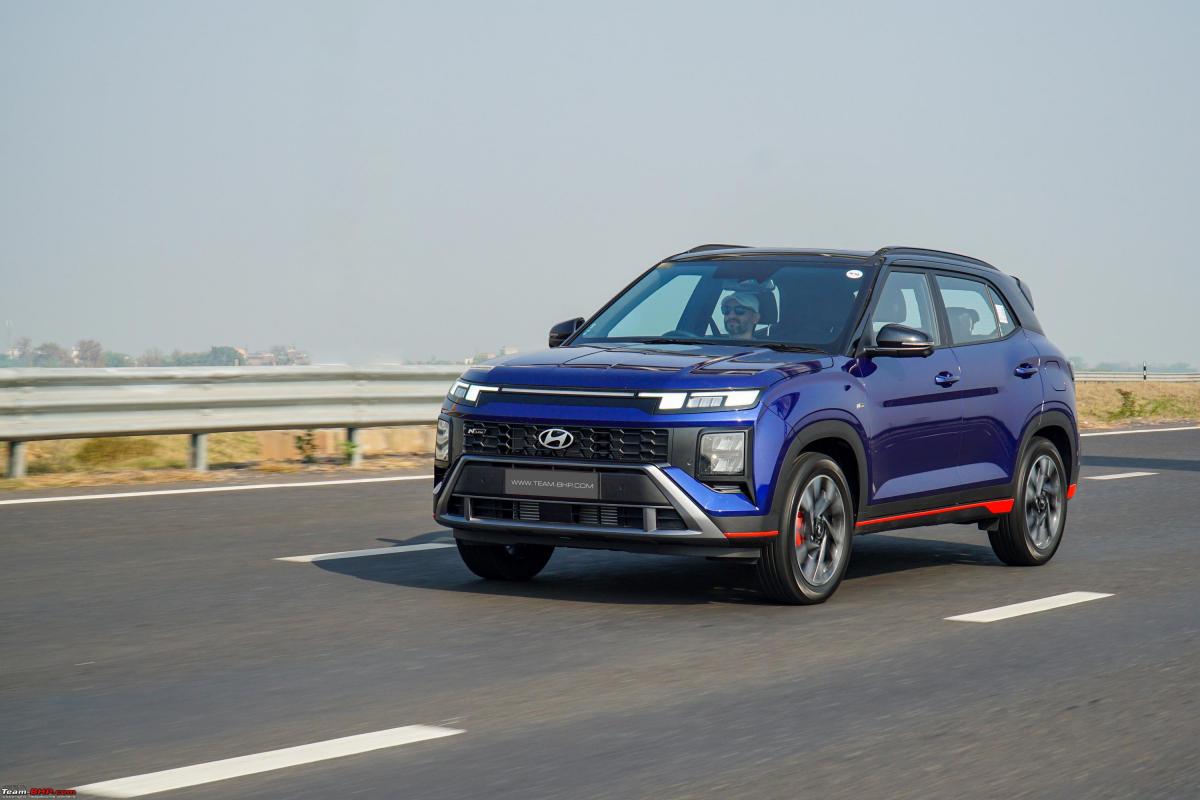
What you'll like:
- Distinct N-Line touches set it apart from the regular Creta
- Punchy 158 BHP, 1.5L turbo-petrol motor mated to a 6-speed MT or 7-speed DCT
- Firmer suspension coupled with weighted steering make the Creta N-Line fun to drive
- Tasteful N Line-exclusive steering wheel, gear selector, red accents, etc. liven up the interior
- Feature-rich equipment list includes LED headlamps & tail-lamps, panoramic sunroof, dual-zone climate control, ventilated seats, 360-degree camera & more
- Price premium over the regular Creta is justified by the additions & improvements
- Safety kit = ADAS Level 2, 6 airbags, TPMS, hill assist, dashcam (only N8 variant), auto headlamps etc.
What you won't:
- Without a power bump, it feels more like an additional variant rather than a performance-oriented model of the Creta. Hyundai should've tuned the N-Line engine for some more power
- N-Line specific design changes may not be to everyone’s liking
- Although well-priced in relation to the SX(O) variant, it is still an expensive crossover
- Firmer suspension means bad roads & bumps are felt more than in the regular Creta
- 6-speed MT should've had shorter throws & clutch travel should have been shorter in the N-Line variant
- Some misses (no auto wipers, illuminated window buttons, full-size spare tyre on top trim)
- Back seat's width makes it better for 2 adults and a kid, rather than 3 adults
Kia Seltos
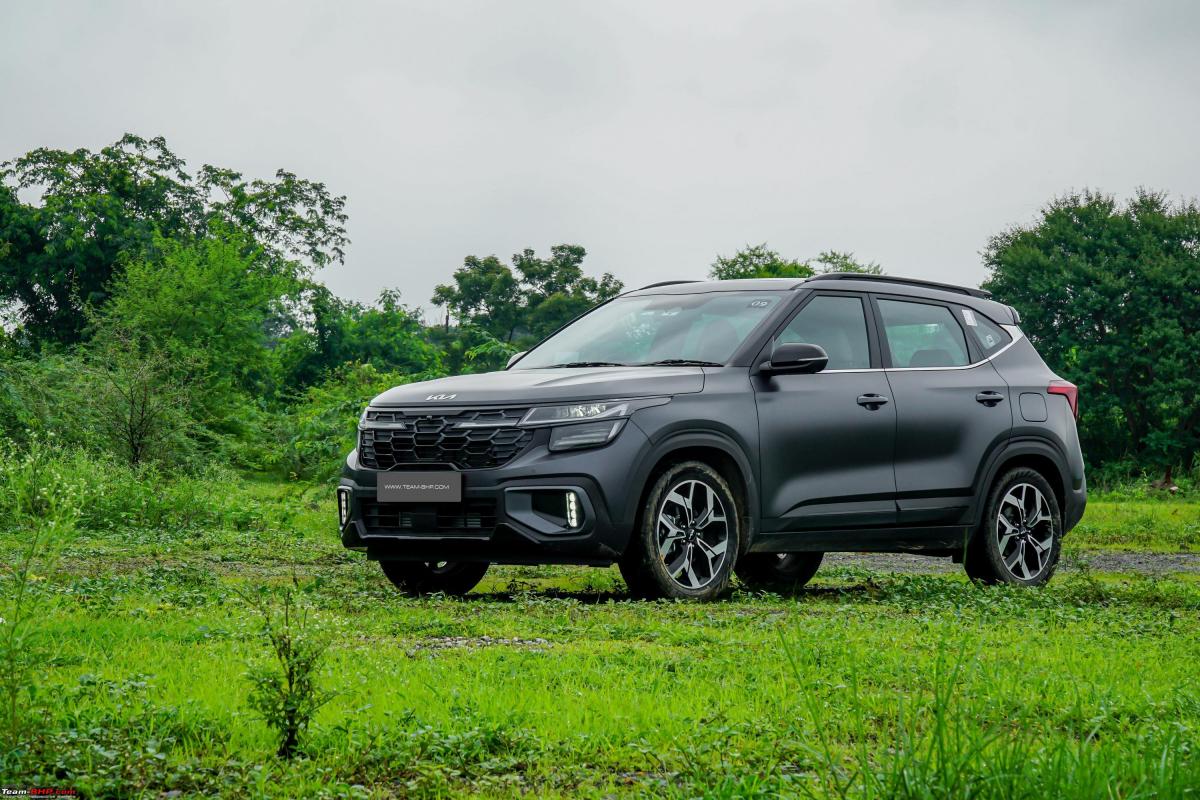
What you'll like:
- A superbly engineered all-rounder that delivers a premium experience
- Handsome, contemporary styling. Looks very sharp
- We find the Seltos to be well-priced for what it offers
- Nice, user-friendly interiors with sufficient space & good quality
- Loved the punchy 1.5L turbo-petrol
- Mature on-road behavior, including at highway speeds. A+ brakes as well
- Unusually wide variant offering. Seems there is something for everyone
- Safety kit includes 6 airbags, ESP, all-wheel disc brakes, blind spot monitor, TPMS etc.
What you won't:
- Back seat's width makes it better for 2 adults and a kid, rather than 3 adults
- Dual-clutch ATs (like the Petrol DCT) have a history of poor reliability in India
- Extremely confusing & complicated variant spread
- You get bigger SUVs & Crossovers for the same money (e.g. Hector, Harrier, XUV700)
Volkswagen Taigun

What you'll like:
- Has its own fresh, European character in a segment dominated by Indian, Korean and Chinese SUVs
- Unmistakably VW styling matched with solid European build quality
- Cabin has good legroom to offer, supportive seats, perfect ergonomics & lots of storage
- 148 BHP engine makes the Taigun one of the most fun-to-drive crossovers in the segment!
- Sporty 1.0L & 1.5L turbo-petrols are mated to slick 6-speed MTs & smooth ATs
- Sorted suspension offers a balanced ride & handling package
- Safety features include up to 6 airbags, ESC, 3-point seatbelts for all, electronic differential lock, brake disc wiping, multi-collision brake and more
- Features like active cylinder tech, ventilated seats, sunroof, 10-inch touchscreen with wireless Android Auto and CarPlay, auto headlamps & wipers etc.
- 5-star GNCAP safety rating - full details here!
What you won't:
- DQ200 DSG transmission has a history of poor reliability & breakdowns in India
- Narrow cabin width makes a 5th adult completely unwelcome. Best for 4 onboard
- Interior colour scheme and quality don't feel up to traditional VW standards. Some polarising details too (chrome outside, painted plastics inside...)
- Sure lacks the street cred / presence offered by some competitors
- VW’s after-sales service can be a hit or miss. Many VW owners find it expensive too
- Turbo-petrols are very sensitive to driving style. FE will drop drastically when you drive hard
Skoda Kushaq
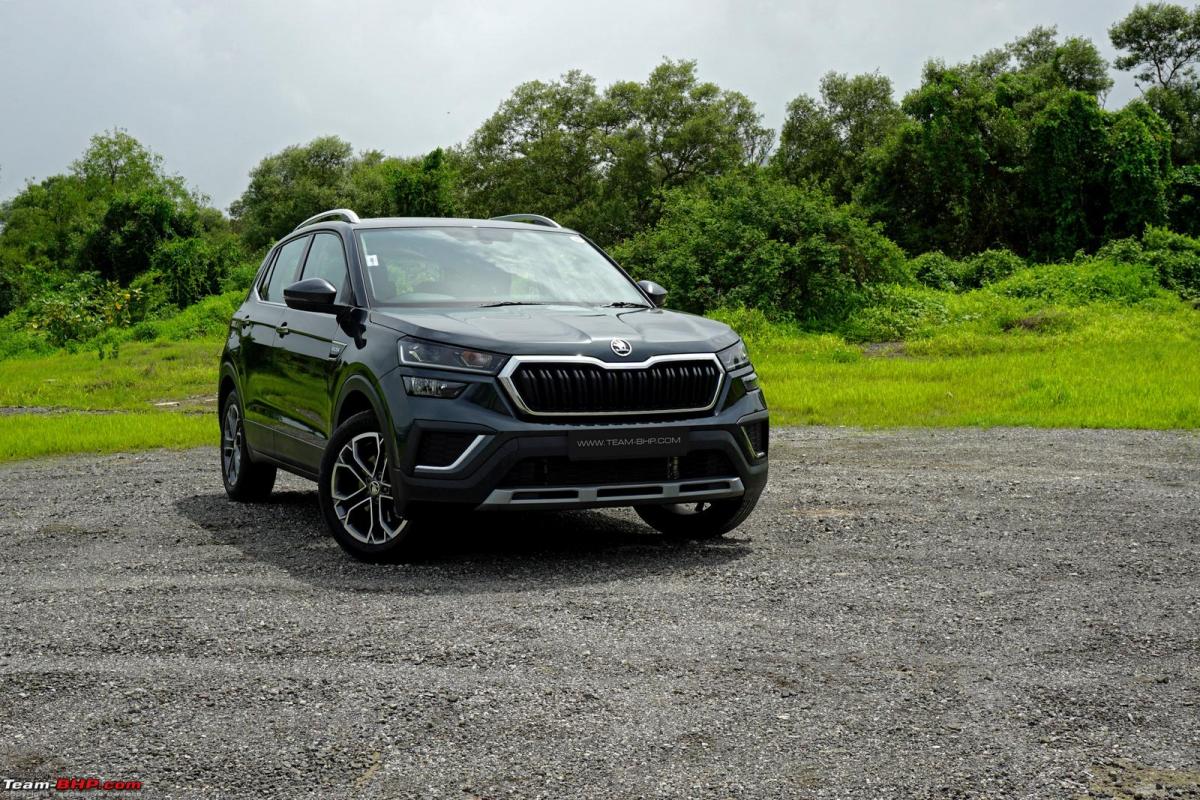
What you'll like:
- A breath of fresh (European) air in a sea of Korean, Chinese & Indian SUVs
- Classy exterior & interior styling matched with solid European build quality
- Cabin has good legroom to offer, supportive seats, perfect ergonomics & lots of storage
- 148 BHP engine makes the Kushaq one of the most fun-to-drive crossovers in the segment
- Sporty 1.5L turbo-petrol is mated to slick 6-speed MTs & smooth ATs
- Sorted suspension offers a balanced ride & handling package
- Safety features include 6 airbags, ESC, 3-point seatbelts for all, electronic differential lock, brake disc wiping, multi-collision brake and more
- 6-year extended warranty & 4-year all-inclusive service packages available
- Features like active cylinder tech, ventilated seats, sunroof, wireless Android Auto and CarPlay, audio system with a punchy subwoofer, auto headlamps & wipers etc.
- 5-star GNCAP safety rating - full details here!
What you won't:
- DQ200 DSG transmission has a history of poor reliability & breakdowns in India
- Narrow width makes a 5th adult completely unwelcome. Best for 4 onboard
- At 385 litres, boot space is lesser than its direct rivals (Creta & Seltos = 433L)
- Sure lacks the street cred / presence offered by some competitors
- Skoda’s notorious dealerships & after-sales horror stories
- Turbo-petrols are very sensitive to driving style. FE will drop drastically when you drive hard
Mahindra XUV700
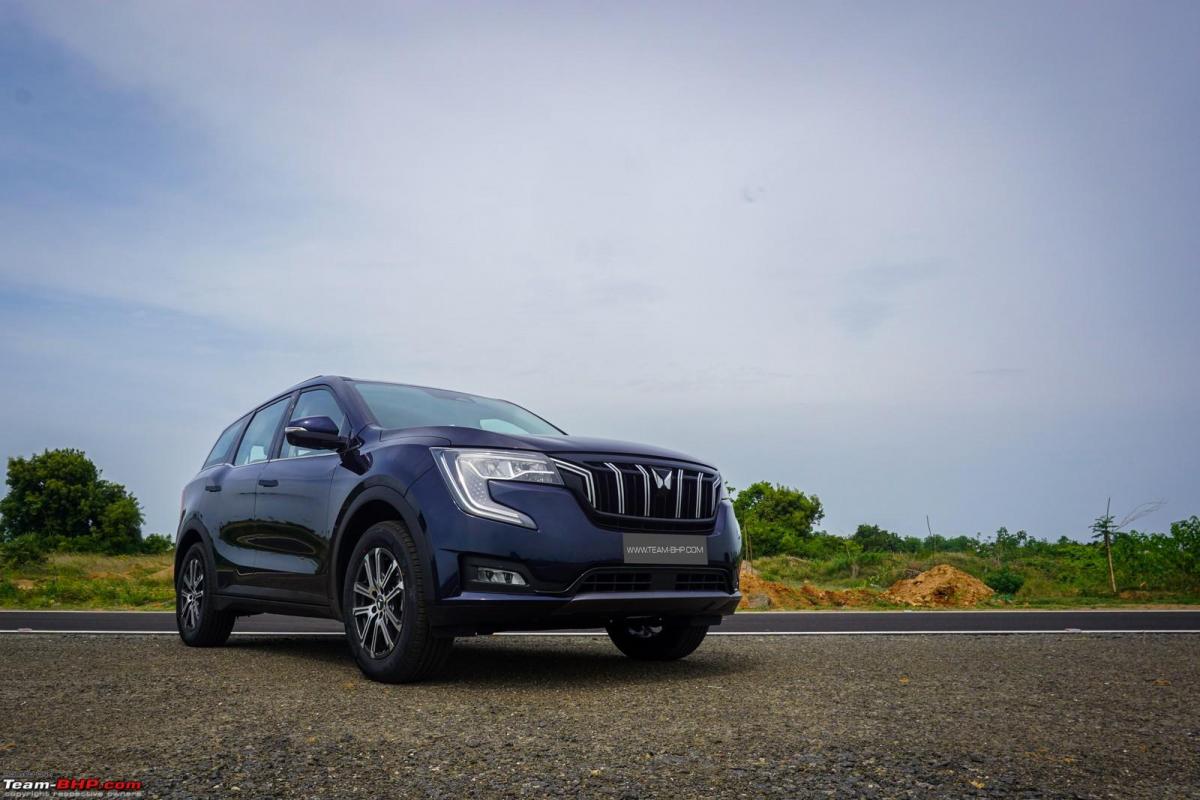
What you'll like:
- Handsome styling matched to solid build quality. Has street presence, feels robust
- Very spacious interiors with comfy seats and sorted ergonomics. 6-footer passengers welcome!
- 197 BHP turbo-petrol mated to a smooth 6-speed torque converter
- Sorted suspension with good road manners & high-speed stability
- AWD available for the adventurous, unlike most FWD crossovers in the segment
- Loaded with features like radar-based driver assistance system, pop-out door handles, panoramic sunroof, driver memory seat, 360-degree camera, 10.25" infotainment & instrument cluster etc.
- 12-speaker Sony audio system is fantastic! You'll enjoy its sound quality
- Safety features include 7 airbags, ESP, all-wheel disc brakes, hill hold, hill descent control, driver drowsiness detection, TPMS, ISOFIX...
What you won't:
- Petrol AT is thirsty due to its hefty weight, 197 BHP & torque-converter AT
- Some cabin plastics & a few rough areas don't feel premium in an otherwise loaded SUV
- Missing features such as an auto-dimming IRVM, paddle shifters, full-size spare wheel, ambient lighting, rear sunblinds...
- Concerns over niggles & bugs in a freshly baked, complex Mahindra
- Mahindra's after-sales service is a hit or miss. Remains a gamble
- AWD is not available with the petrol motor
Here's what GTO had to say about the matter:
Damn good time to be in the market for a 20-25 lakh crossover! Those are some seriously competent turbo-petrols. The new Seltos looks deadly, the Creta N-Line is nice (both offer 158 horses!), the VW & Skoda siblings are a pure driving delight with their 1.5L turbo-petrol DSGs and of course, there is the 200 BHP XUV700. Although, as great as the XUV700 is, it cannot match the other 4 in terms of sheer driving pleasure.
Between the Creta N-Line & Seltos, I'd still go for the latter in the deadly matte grey.
Between the Taigun & Kushaq, I'd pick the Skoda.
But really, this is one tough poll. If it came to putting my money down, it would be the Seltos 1.5L Turbo-Petrol. 2nd choice XUV700 only if I needed a bigger SUV.
Here's what BHPian tp_dominator had to say about the matter:
Voted for the Seltos X - line here as barring XUV700 and considering the other crossovers on the list, it comes out much better in every sense. Ride quality might be a little bumpy with the 18 inchers, but I had the Ford Ecosport with the low-profile 17-inch tyres as standard and compared to that, it's way better.
I feel glad to be owning both the cars - XUV700 and Seltos in their respective top trims in diesel AT guises and our de facto choice for family road trips is always XUV700. Over longer journeys, it has proved to be more comfortable than the Seltos and has ample space and power too. While driving solo too, I have extracted 18-19 kmpl from the XUV700 sometimes and it is as fuel efficient as the Seltos as driving XUV700 at 110-115 kmph delivers the same mileage as driving the Seltos at 100-105 kmph. However, if highway drives are out of the picture and it's going to be occasional, Seltos is better at performing city duties. Just the right size to park in congested areas and overall a better and refined experience than XUV700. For instance, the Auto hold function on the XUV700 doesn't release the brakes as smoothly as the Seltos does and multiple other things including the Auto Start-Stop logic which makes Seltos an overall better city commuter.
Also, the cost of upkeep is going to be lower on the Seltos than the XUV700 as we have the MCP package and regular services are covered till 50k kms in it. But if it has to be a one-car garage, XUV700 will be better.
Here's what BHPian Jaguar had to say about the matter:
Voted with my wallet
After using a Verna for 10 years, the Creta N-Line felt like a natural progression. The electrically adjustable under-thigh support and the beautiful N-Line steering were the biggest attractions for me. It does feel well-built as well.
I had explored all the cars on the poll list except the Seltos. The VAG twins don't hold a candle to the older VAG cars and the cost-cutting is evident on all fronts except the engine. The XUV 700 was too big for my needs and the diesel engine of the XUV felt coarse compared to the one in my Thar.
Here's what BHPian B58lover had to say about the matter:
My pick would be the XUV700, a safe-fast-tech loaded & reliable.
One thing I wanted to ask, is why Creta and Seltos' poor safety rating and unstable structure are not mentioned in the ''What you won't like section''?
Here's what BHPian vattyboy had to say about the matter:
All of the cars mentioned here are equally good, so a buyer cannot go wrong with any of them.
Ultimately, it's just a matter of the buyer's personal preference, especially regarding the appearance of the cars and which brand they prefer.
My personal favourite from this selection is the Creta N line.
Here's what BHPian Shreyans_Jain had to say about the matter:
Choice of fast crossover comes down to the XUV700 petrol and the Taigun/Kushaq 1.5 GT twins. The Creta N Line and Seltos X line will not even be in contention.
If I am looking for a vehicle for purely personal use, then I will get one of the Germans with my eyes closed. Driving pleasure is unmatched. I’ll go for the Kushaq, I prefer its interior ambiance over that of the Taigun.
But if there is an angle of practicality or family usage involved, which is invariably the case for most buyers, I’ll have to go for Mahindra. The much larger cabin and boot space of the XUV700 cannot be matched by the smaller VW/Skoda. It also helps that the 2.0 mStallion is by far the best engine of this lot, and the rest of the car is pretty darn competent as well. The superbly priced and well kitted AX5 variant of the XUV700 is the single most VFM car that can be bought for 20 odd lakh rupees today, while the AX7L is about as loaded as it gets.
Check out BHPian comments for more insights and information.
News
Test drove the Creta N-Line: 5 observations compared to Creta & Seltos
The other strong contender is the Seltos X line but don't really want headaches of maintaining the matte paint.
BHPian Col Mehta recently shared this with other enthusiasts.
Test drove the Creta N line and here are a few observations -
- Ride comfort and suspension: Not as plush as the regular Creta and there is an underlying firmness in low speeds and undulations. But it's not uncomfortable or unsettling. High-speed stability has become better though (we didn't drive too fast, but at 70 plus, the car didn't disappoint). We found it similar to the FL Seltos, however, the regular Creta remains the segment best when it comes to riding comfort in city driving conditions.
- Steering: First thing first - the N steering wheel looks and feels superb. I had reservations initially, but you really have to experience it in person. Coming to functionality, it's heavier than the regular Creta, but thankfully not too heavy in normal mode. The sport mode makes it very heavy which will make things too cumbersome during parking and low speeds - this mode is best suited for highway/high-speed runs. Overall, the steering is well-calibrated and functions as expected.
- Performance: Very similar to the FL Seltos. Still find it laggy in lower gears and can be a little jerky in city traffic when the gearbox is jumping between 1st and 2nd gear. There is a good punch in the mid-range which is enjoyable. Couldn't test the high-speed performance for now, but you can sense that the car has plenty of power to offer. Just wish the low-speed drivability was similar to the NA IVT, which is just butter smooth.
- Exterior: One word - GORGEOUS in the shadow grey color! Just get rid of the red accents and you are sorted. Well, that's my opinion, some might not agree, just like most in our family who are fine with them. The car looks bigger than the regular Creta, thanks to the redesigned front grill and the added spoiler. The Seltos was always the best-looking car in the segment, but not anymore IMHO.
- Interior: The all-black interior theme is not my type. It makes the cabin feel claustrophobic. Some perceive it as premium though, which is fine - personal choice. This is where the Seltos X line excels with its sage green interior which looks so much better than the Seltos GT line and the Creta N line. Interestingly though, the N line interior doesn't feel as cramped as the Seltos GT line. Most likely because of bigger windows and a better sense of cabin space in the Creta, which has always been its USP over the Seltos and it continues with the N line as well.
While I'm not entirely happy with the overall interior quality (that cheap center console and ancient-looking HVAC) and with the black interior which does feel claustrophobic, we are overall happy with the car and seriously considering it over the regular Creta and the Seltos GT line. The other strong contender is the Seltos X line but don't really want the headaches of maintaining the matte paint. I think I will happily get the X line if it comes with color options other than matte. Kia is missing a great trick by not offering more options in the X line, which is bewildering and frustrating.
In case it's going to be the Creta N line, it will have to be in the shadow grey paintwork!
Check out BHPian comments for more insights and information.
- Tags:
- Indian
- Hyundai
- Creta N Line
News
Hyundai i20 N Line owner checks out the Creta N Line N10 DCT
The Creta N Line puts the C right in the CSUV. It's so small for how much it costs, around 26 lakhs on-road in Goa for this variant.
BHPian pepega recently shared this with other enthusiasts.
While waiting for my i20 N Line to get serviced, I checked out the Creta N Line. Aero gap in the front bumper: This is the N10 (top) DCT auto variant:
The car looks very good from the front. This will be a major selling point.
Front left:

Front right:

Aero gap in the front bumper:

Front grill. The front camera is tucked within the Hyundai logo.
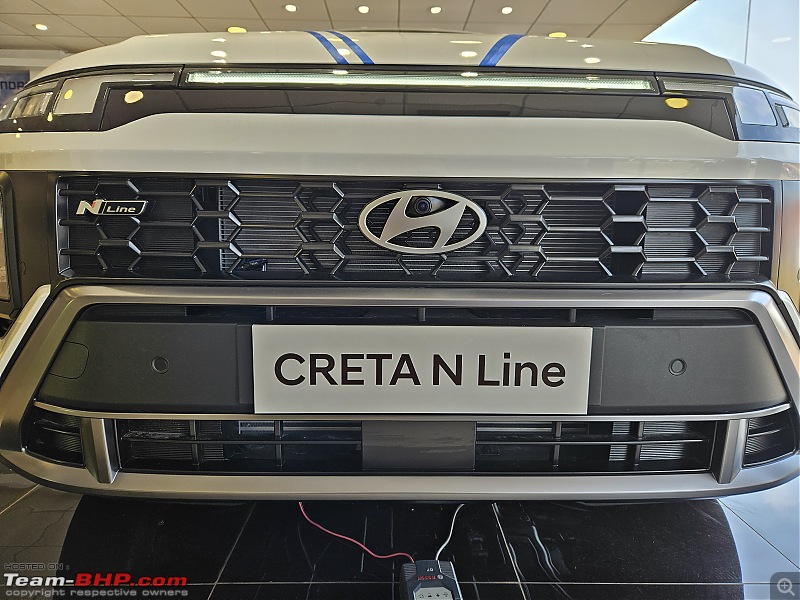
Four front sensors, two on each side. H symbol DRLs, and LED projectors:
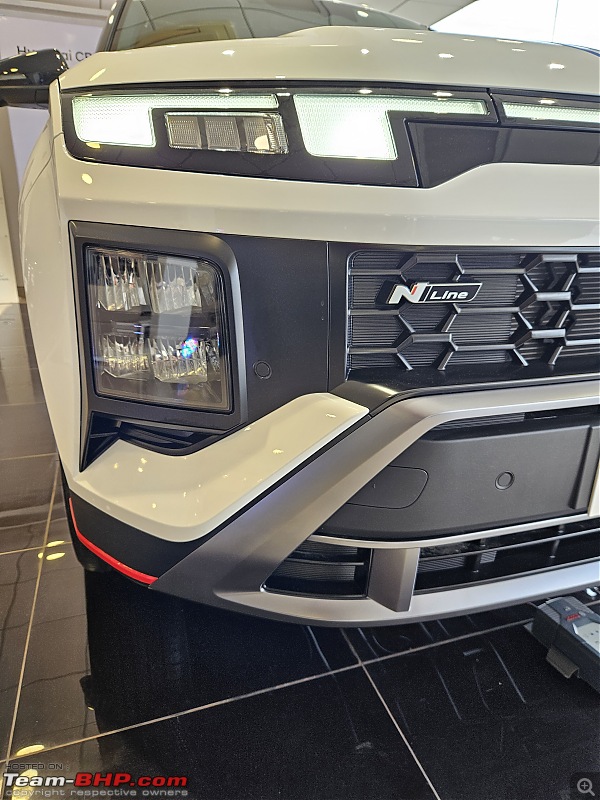
Moving onto the side looks.
New alloys and "sporty" red cladding make the N Line stand out:
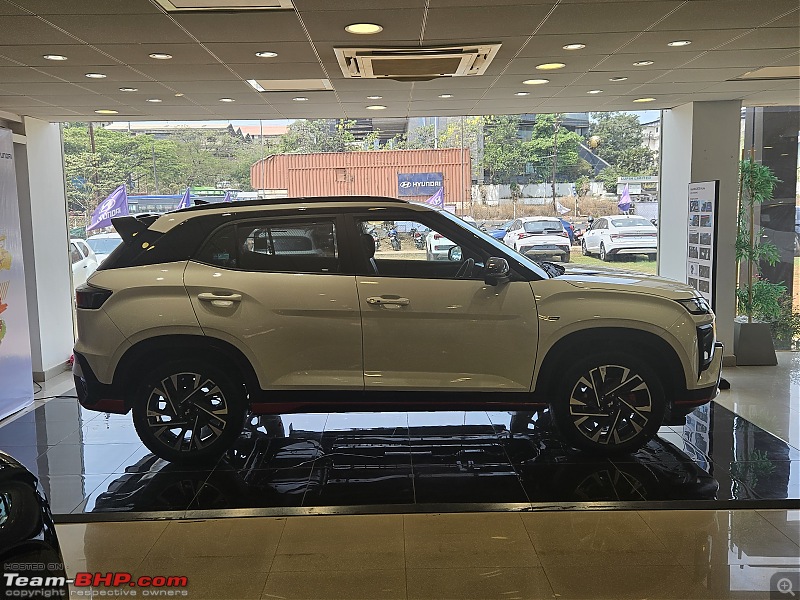
Side cameras are on the ORVM:

Only the front driver side gets the request sensor. Not the passenger side. The boot also doesn't come with a request sensor, but it will open if you are standing nearby with the key (even if the car is locked). I hate this kind of cost-cutting at the top-end of the top-end.
Driver side:

Passenger side:

Closer look at the rear:
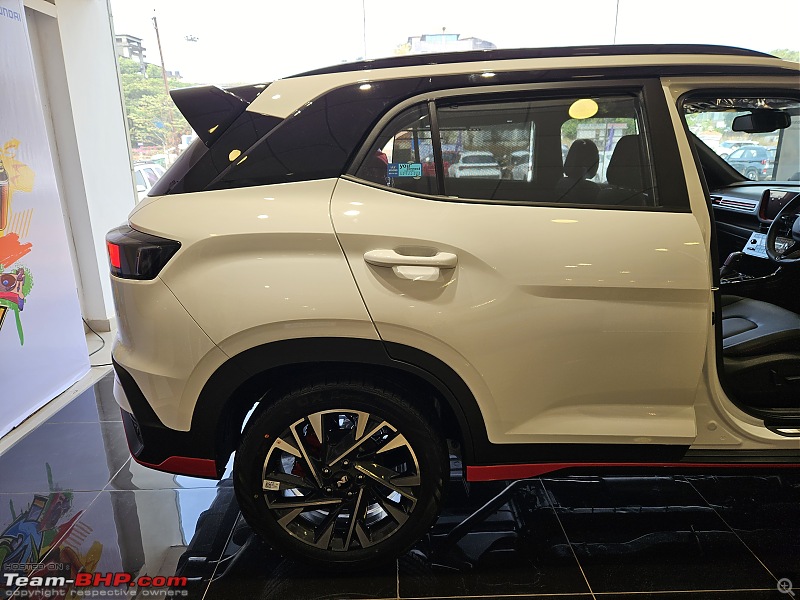
With the boot open:

Roof cladding should protect the sunscreen somewhat:
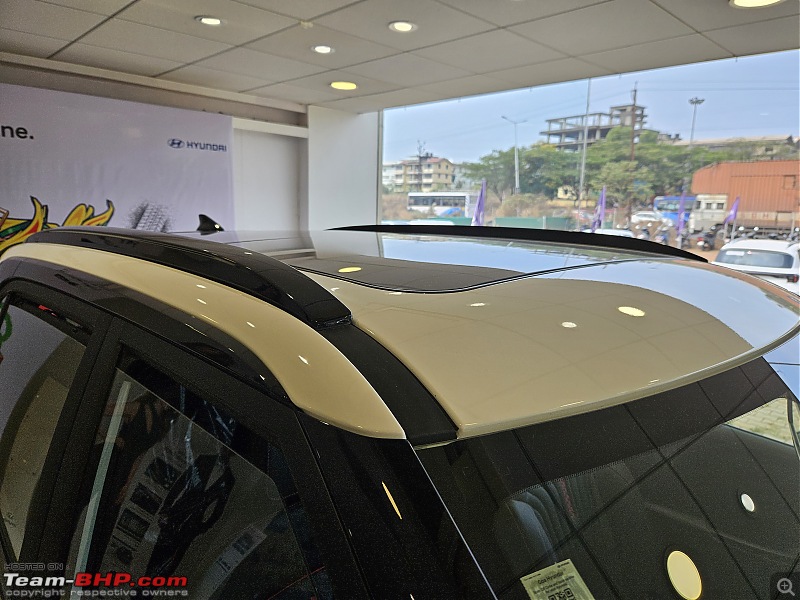
Moving onto the rear.
Back:

Exhaust:

Boot space seems a little small:

Moving onto the interiors.
The doors are hefty and close with a satisfying thud. I wonder how much thud engineering went into designing them:
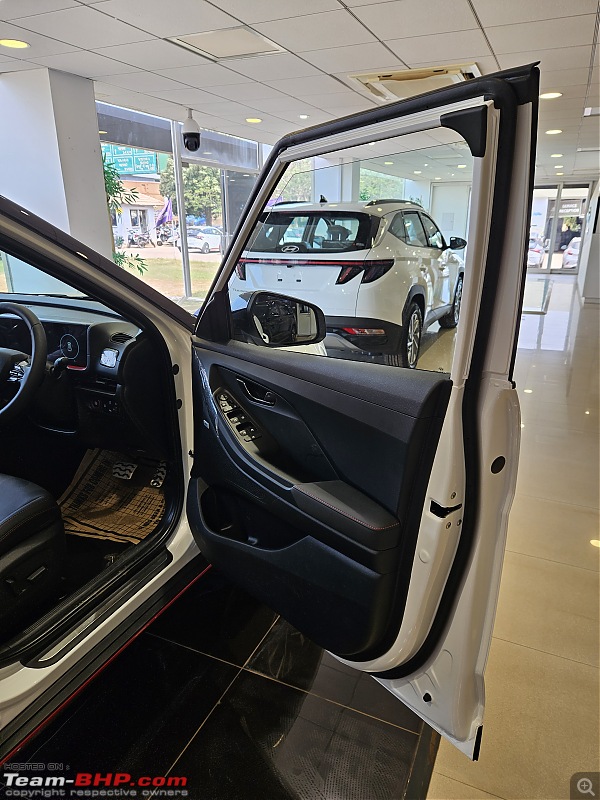
Rear door has a privacy cover. Very nice feature:

Passenger side view of the interior:

Rear interior look:

There is Bose badging all over the cabin:

Steering wheel and driving position remind me a lot of my i20 N Line:

Gear knob is identical to the one in the i20 N Line. Everything else in this console is new and exclusive to the Creta:

Nice chunky buttons for the ventilated seats:
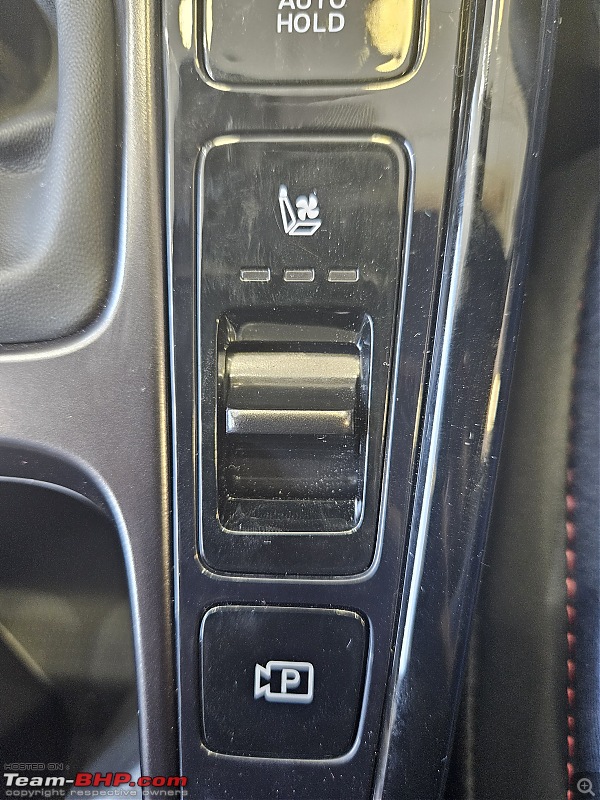
Some ADAS control buttons maybe?

Lots of charging ports:
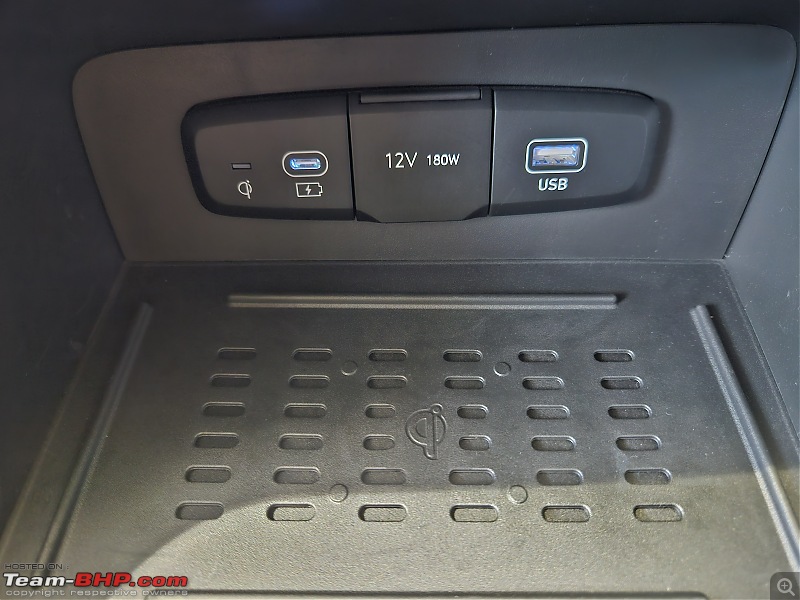
AC controls have proper buttons:

Space in the rear feels cramped with my driving position. What did they do with all that extra length?

Rear Climate control doesn't seem to include an air purifier:

Three point seatbelt for the middle passenger is a must:

And finally, each Creta purchase comes with your own personal standee of Shahrukh Khan and Deepika Padukone:

The Creta N Line puts the C right in the CSUV. It's so small for how much it costs, around 26 lakhs on-road in Goa for this variant. I guess the small size helps its sporty characteristics. But for this much money, I would want something larger in size. That would feel more VFM.
My final thoughts are that a sporty Creta automatic with 160 bhp shouldn't be unleashed on Indian roads. Considering that most cars in India are still running on 80-90 bhp, this monster will bully cars and create memes like never before. Personally, I am not mature enough to drive this responsibly.
Check out BHPian comments for more insights and information.
- Tags:
- Indian
- Hyundai
- Creta N Line
- Creta
News
A 1st gen Creta owner checks out the 2024 N-line: His observations
We are still contemplating the Creta N-line alongside the Seltos. Will take a comprehensive TD to understand the dynamics and drive experience before taking the final call.
BHPian Col_Mehta recently shared this with other enthusiasts.
Saw the car more closely today. The Shadow Grey looks absolutely gorgeous! The red lines look too loud to me, but my grandson loves it! The younger generation in our family doesn’t seem to mind that a lot. Really liked the front grill and the 18 inch alloys that make the car a lot desirable than the regular Creta. Somehow the car looks a lot bigger and butch and I have no hesitation to say that it’s the best looking car in the segment (just blacken the red accents).
One interesting observation - the all black cabin is dark, but doesn’t feel as claustrophobic and smaller as it does in the Seltos GT trim. Same goes for the pre FL turbo Creta with all black interior that I have driven quite extensively. Larger windows which lends an airy cabin sense could be the possible reason. Having said that, I’m still not a big fan of the cabin and prefer one with lighter theme. The center console, however, is still the biggest chink in its armour and remains our biggest gripe with the interior. It creaks and feels plain cheap.
The N steering wheel is smaller than the regular one and may look out of place in the first glance, but after a few minutes, it actually felt nice. It’s chunky and delightful to hold. The steering mounted buttons and paddle shifters feel more plush to use. Same goes for the gear knob, while the regular AT gear knob is our favourite, this one looks and feels quite good too.
We are still contemplating the Creta N line alongside the Seltos. Will take a comprehensive TD to understand the dynamics and drive experience before taking the final call.
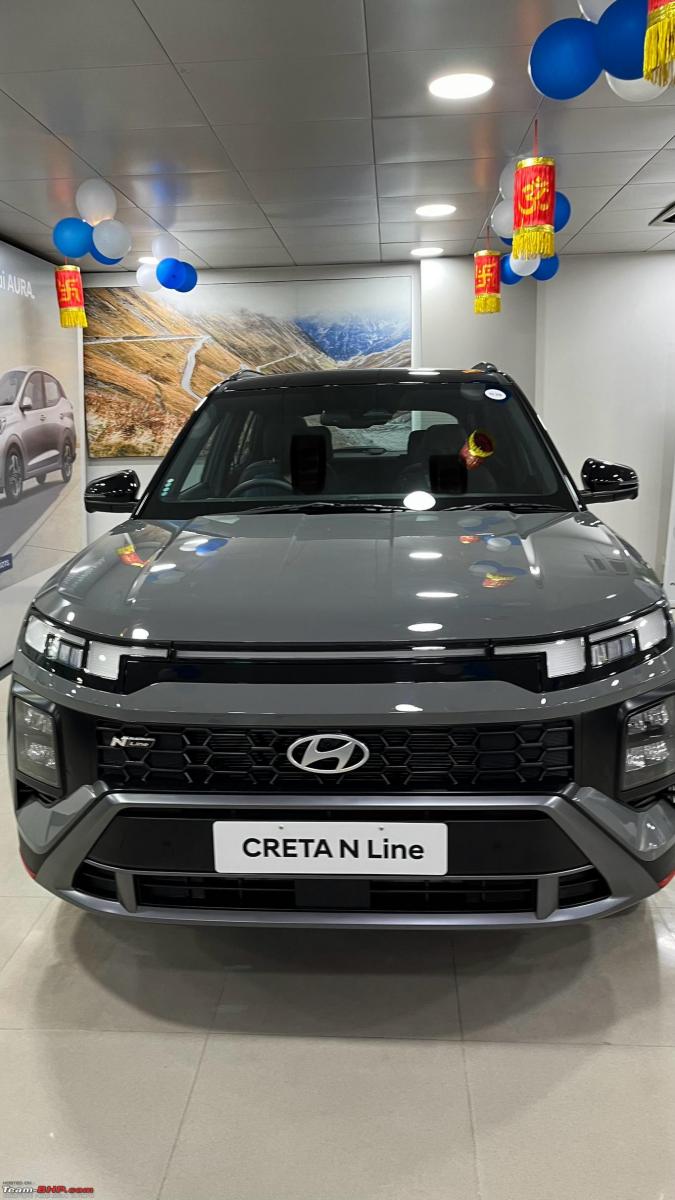
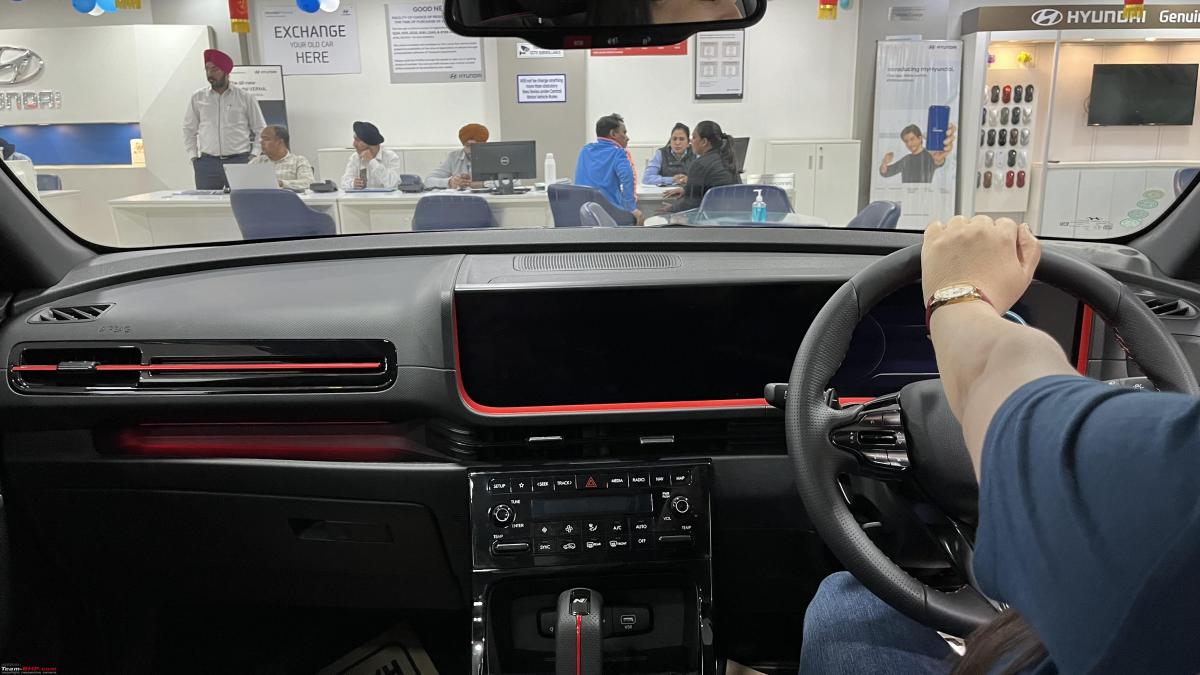
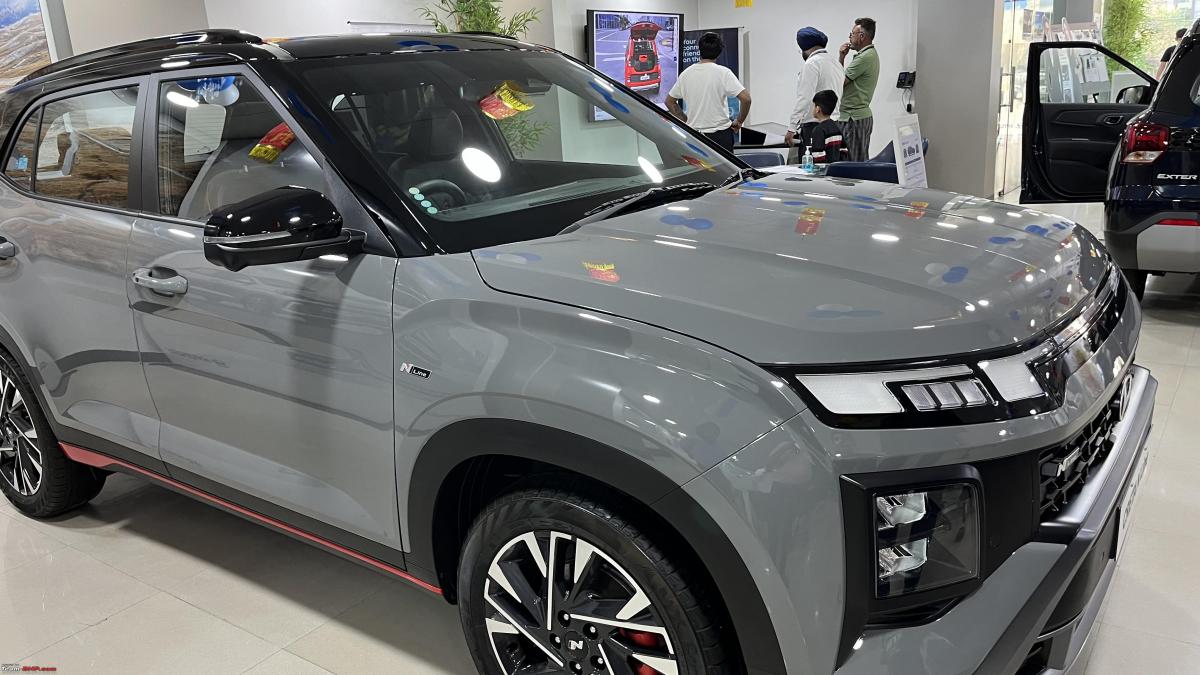
Read BHPian comments for more insights and information.
News
Gen-1 Creta owner considers buying 2024 model: Test drive observations
The Seltos is a possible contender, but it does not have NA IVT on its top trim
BHPian Col Mehta recently shared this with other enthusiasts.
SX(O) IVT Test Drive Experience:
Engine and Gearbox Performance - Exceptionally smooth, refined, and good to drive. This has always been one of the positives of this engine-gearbox combo. The car is just ever so easy to drive in city traffic conditions. With no lags, no jerks, no drama, and with m-o-r-e than enough power to pot around all day alone, this car excels in urban settings. If you are mostly going to drive within city limits with occasional highway runs and want all the latest bells and whistles, then look no beyond this car.
Steering Response - The steering feels noticeably lighter than the outgoing model that we drive (2021 SXO IVT). It's a welcome change as it does not feel unnecessarily heavy at parking and slow speeds. The steering response on the previous model has vague feedback from the steering. Not always, but it feels like it has its own mind at times. This we did not feel in the FL model. The steering feedback remained consistent and a tad lighter which we liked.
Ride Quality - One word - Plush! Just the right balance really - not too soft, not too stiff either. On slow speeds, it does not get unsettled while going through potholes/uneven surfaces. At higher speeds, it almost glides through everything without making the passengers uncomfortable. All this when the TPMS showed 40+ on all four tyres!
Interiors - Well this is where this car disappoints. While the overall look and feel of the interiors are satisfactory, that ancient-looking HVAC system and the cheap glossy plastic on the centre console (which still makes creaking noise by the way) take away all the premiumness. The AT centre console is amazing to look at (if you overlook that low-grade plastic), but we are very disappointed with Hyundai for not addressing the plastic quality in this FL. Despite having received consumer feedback and ample time to rectify the issue, they chose not to. Another concern for us is the all-grey interior theme which we did not like, particularly on bright sunny days when abundant sunlight enters the cabin, accentuating the blandness. Hyundai should have retained black elements to elevate the ambiance.
Built Quality - The outgoing model is not known for its built quality and feels lighter than the first-gen model (we have both generations within our family). This one, interestingly though, felt better! The doors are heavier, and the overall feel is superior. I hope Hyundai sends it for the crash test and comes back with 5 stars!
So, did we like it to replace our first gen Creta? - Honestly don't know. While we LOVE the 1.5 NA IVT combo, perfectly suited to our needs, and the ride quality and steering response are just how we like them, the underwhelming interior feel is what killing us. Thinking about other options in the segment, there is none like the Creta. The Seltos is a possible contender, but it does not have NA IVT on its top trim plus those so-called "sporty" all-black claustrophobic interiors are a no-go! Perhaps the Xline could be an option with its captivating sage green theme, but then it also comes with its own set of maintenance challenges. Why does it have to be so complex, KIA?
We are keeping our booking for now (yes, we booked it last month), but aren't entirely convinced.
Check out BHPian comments for more insights and information.
News
Hyundai Creta N-Line : Our observations after a day of driving
The turbo kicks in at ~1,500-1,600 rpm and you’re greeted with a strong surge of acceleration. The engine pulls hard and you will reach triple-digit speeds in no time.
Driving the Hyundai Creta 1.5L Turbo-Petrol 6-speed MT
Powering the Hyundai Creta N-Line is a 4-cylinder, 1.5L turbo-petrol engine producing 158 BHP @ 5,500 rpm and 253 Nm @ 1,500-3,500 rpm. We’ve driven this engine with the 7-speed DCT in the Hyundai Verna, Kia Seltos and the Hyundai Creta facelift. It’s quite an impressive engine and a worthy upgrade from the old 1.4L turbo-petrol engine from Hyundai-Kia. However, when it comes to the transmission options, only the Verna and the Creta N-Line are offered with a proper 6-speed manual transmission. The Seltos gets an iMT which most enthusiasts turn a blind eye to, and the regular Creta is offered only with the 7-speed DCT.
At idle, the engine is refined, and you don’t hear it inside the cabin at all. Right off the bat, you will notice that the clutch travel is a bit long like most regular Hyundais. You’ll get used to it like in most Hyundais and getting off the line is pretty smooth. At low speeds, you don’t really feel any turbo lag. There’s enough grunt at low revs for puttering around in the city. Unlike most turbo-petrols, which feel very spiky and eager to pounce, you can drive the Creta N-Line MT smoothly. Of course, flex your right leg and the car is more than capable of putting all those horses to good use. But in the hands of a sedate driver, the N-Line won’t feel out of place. The lower gears are tall and you won't feel the need to constantly shift when driving in the city.
Get on the open road and you will be able to properly stretch the legs of the Creta N-Line. With 158 BHP on tap, the straight-line acceleration is impressive. The turbo kicks in at ~1,500-1,600 rpm and you’re greeted with a strong surge of acceleration. The engine pulls hard and you will reach triple-digit speeds in no time. The meat of the power band is from ~2,000 rpm to 5,000 rpm after which the power starts tapering off. As is the case with most turbo-petrol engines, the redline is conservatively marked at 6,500 rpm. The engine however revs only till 6,250 rpm after which the rev limiter kicks in and the fuel cuts off aggressively. So if you’re planning to hit max revs before upshifting, not a good idea. You’ll see the 1st gear max out at ~52 km/h and the 2nd gear at ~95 km/h.
Even on the highways, the driveability is good and you can munch miles comfortably. In 6th gear, the car cruises at 100 and 120 km/h at ~2,100 and 2,500 rpm respectively. In most cases, you won’t have to downshift if there’s no traffic around and you can get ahead of other cars quite comfortably. Only if you need to pass a car very quickly will you need to drop down a gear and in some rare cases, two gears. At no point, will you feel that the engine lacks the power to overtake.
As mentioned earlier, the clutch travel is not as short as you would expect in a performance-oriented car. The good thing is that the clutch is light. It's just that the long travel takes away some of the fun when pushing the car and moving through the gears quickly. The clutch feel & travel is very similar to the older Seltos 1.4 turbo-petrol 6-speed MT. Talking about the 6-speed MT gearbox on the Creta N-Line, the gear knob is lovely to hold. The throws, however, are long and we would have liked them to be shorter. There is a hint of notchiness in the shifts, especially when moving between 2nd and 3rd gears. Note that these comparisons are keeping in mind that this is a performance-focused variant. Drive it like a regular car and you probably won't find anything to complain about. The gearbox is sure-slotting for you to enjoy shifting gears.
Noise, Vibration & Harshness (NVH)
When we drove the Creta facelift recently, we found the NVH levels impressive. The engine is very refined and you can barely hear it while driving around in the city. However, this being an N-Line we were expecting an enthusiastic exhaust note. Unfortunately, that’s not the case. The exhaust is barely audible inside the cabin. If you’re expecting a fruity exhaust note like the i20, you’ll be disappointed. At high rpms, the engine gets boomy and isn’t something enthusiasts will enjoy.
Mileage & Fuel economy
The Creta N-Line comes equipped with an auto start-stop feature that helps fuel efficiency in city driving conditions. The ARAI-certified fuel efficiency for the 1.5-litre turbo-petrol 6-speed MT is 18 km/l which is a little better than that of the Seltos 6-speed iMT (17.7 km/l). Of course, the real-world FE numbers will be much lower considering that turbo-petrol engines are very sensitive to driving style. We’ll wait for some ownership reviews to get a better picture of the real-world fuel efficiency. The fuel tank capacity remains the same as the regular Creta at 50 litres.
This 1.5L, 4-cylinder turbo-petrol engine makes 158 BHP @ 5,500 rpm and 253 Nm @ 1,500-3,500 rpm:

6-speed manual gearbox should’ve had shorter throws:

Suspension
Ride Comfort
Compared to the regular Creta, the N-Line's ride is noticeably different. The car rides on 18-inch alloy wheels shod with 215/55 section tyres as opposed to 17-inch wheels on the regular Creta. Furthermore, Hyundai has stiffened up the suspension to make it sportier. While driving around at low speeds, you feel a lot of the road. Small potholes and speed breakers register themselves sharply. If ride comfort is an important deciding factor for you, you’re better off with the regular Creta. The N-Line’s ride is on the stiffer side and very similar to that of the pre-facelift Seltos.
Handling & Dynamics
Thanks to the stiffer suspension setup, the high-speed stability is pretty good. On the expressways, there’s no unnecessary bounciness or floatiness at triple-digit speeds. The car is planted and has good composure. Expansion joints of the city flyovers are also absorbed nicely.
Dynamics is where the N-Line has had major gains. The stiffer suspension setup allows you to carry more speed into the corners. You can attack some really tight corners and there’s very little understeer. Body roll is well controlled and the car doesn’t feel like it will lose composure at any point. Traction control does limit you if you go too aggressive, but it doesn’t cut off the power sharply. Even high-speed corners are handled very well by the N-Line. The JK UX Royale tyres managed to provide enough grip, but they did chirp quite a bit when pushed hard. If you want to extract some more performance, you should definitely upgrade to wider Michelin or Yokohama rubber.
Steering
While the difference between the steering of the regular Creta and the N-Line isn’t much, the latter does feel a little more direct. The EPS is well-tuned and light at city speeds. As you build up speed, it weighs up fairly, but considering this is an enthusiast-focused car, we’d have wished that there was a bit more weight. In corners, the steering feels light, but has a more consistent feel to it. You can turn into a corner carrying good speed smoothly and straighten out without feeling too nervous.
Braking
The braking in the Creta N-Line 6-speed MT was surprisingly very different from the Creta DCT that we drove in January. Where the brakes in the DCT variant felt over-served and extremely sharp, the pedal feel of the N-Line 6-speed MT was a lot more consistent. The brake pedal felt a lot more progressive in corners and allowed the car to shed speed smoothly. Emergency braking situations were handled well and the car managed to stop without any drama.
Continue reading the discussion on the Hyundai Creta N-Line on our forum.
- Tags:
- Indian
- Hyundai
- Creta N Line
News
2024 Hyundai Creta N-Line Review : 7 Pros & 7 Cons
The Hyundai Creta N-Line is available only with the 158 BHP, 1.5-litre turbo-petrol engine and comes with either a 6-speed manual transmission or a 7-speed dual-clutch automatic.
Hyundai Creta N-Line Pros
- Distinct N-Line touches set it apart from the regular Creta
- Punchy 158 BHP, 1.5L turbo-petrol motor mated to a 6-speed MT or 7-speed DCT
- Firmer suspension coupled with a weighted steering make the Creta N-Line fun to drive
- Tasteful N Line-exclusive steering wheel, gear selector, red accents, etc. liven up the interior
- Feature-rich equipment list includes LED headlamps & tail-lamps, panoramic sunroof, dual-zone climate control, ventilated seats, 360-degree camera & more
- Price premium over the regular Creta is justified by the additions & improvements
- Safety kit = ADAS Level 2, 6 airbags, TPMS, hill assist, dashcam (only N8 variant), auto headlamps etc.
Hyundai Creta N-Line Cons
- Without a power bump, it feels more like an additional variant rather than a performance-oriented model of the Creta. Hyundai should've tuned the N-Line engine for some more power
- N-Line specific design changes may not be to everyone’s liking
- Although well-priced in relation to the SX(O) variant, it is still an expensive crossover
- Firmer suspension means bad roads & bumps are felt more than in the regular Creta
- 6-speed MT should've had shorter throws & clutch travel should have been shorter in the N-Line variant
- Some misses (no auto wipers, illuminated window buttons, full-size spare tyre on top trim)
- Back seat's width makes it better for 2 adults and a kid, rather than 3 adults
- Tags:
- Indian
- Hyundai
- Creta N Line
News
Hyundai sells over 22,000 Venue & i20 N Line models
13% of N Line buyers are women and 82% prefer the top-spec variant.
Earlier this week, Hyundai launched its third N Line model, the Creta N Line, in India. It is an indication of how these models have gained popularity.
According to the company, over 22,000 units of the Venue N Line and i20 N Line have been sold. N Line models contribute to over 20% of the brand’s overall sales of the turbo-petrol models.
On the sidelines of the Creta N Line launch, Tarun Garg, Chief Operating Officer of Hyundai India, stated that at 13%, women N Line buyers cross the average women buyer consumer base in India’s passenger vehicle market. He added that 82% of N Line buyers prefer the top-spec variant.
Hyundai’s N Line range not only offers a sportier design but also comes equipped with decent performance upgrades. The N Line cars get a stiffer suspension setup, retuned steering and a sportier exhaust.
Source: Autocar India
News
Hyundai Creta N Line launched at Rs 16.82 lakh
The Hyundai Creta N Line is available in two trims N8 and N10, with a choice of a 6-speed manual or a 7-speed DCT.
Hyundai has announced the launch of the Creta N Line. As you may have guessed, this is the sportier version of the standard Creta. It is available in two trims N8 and N10 with prices starting at Rs 16,82,300 (ex-showroom).
The Creta N Line is based on the recently introduced Creta facelift. The SUV looks sportier than the standard version. It features a different rectangular front grille and bumper with silver inserts, L-shaped LED DRLs and 18-inch dual-tone alloy wheels with red brake calipers. It has a sporty bumper at the rear with dual-tip exhaust, a roof spoiler and side skirts with red highlights.
The Creta N Line features a sporty interior with black upholstery and red accents on the dashboard, gear lever and seats. The N Line version also gets a 3-spoke steering wheel, metal pedals and a new gear lever. The SUV is equipped with a 10.25-inch touchscreen infotainment system and a digital instrument cluster. It also gets ventilated front seats, a powered driver’s seat, a panoramic sunroof, dual-zone automatic climate control, a wireless charger. a Bose sound system, a 360-degree camera, a dual dash camera, and ADAS.
The Creta N Line is powered by a 1.5-litre turbo-petrol engine, producing 158 BHP and 253 Nm. The engine is paired with a 6-speed manual and a 7-speed dual-clutch automatic transmission with paddle shifters. Hyundai claims it can accelerate from 0-100 km/h in 8.9 seconds. The N Line version also gets a stiffer suspension setup for more focused handling characteristics, tweaked steering and a tuned exhaust.
The Creta N Line is available in three monotone and dual-tone colour options - Atlas White, Abyss Black, Titan Grey Matte, Thunder Blue with Abyss Black roof, Atlas White with Abyss Black roof, and Shadow Grey with Abyss Black roof.
Hyundai Creta N Line ex-showroom prices:
- N8 MT - Rs 16,82,300
- N8 DCT - Rs 18,32,300
- N10 MT - Rs 19,34,300
- N10 DCT - Rs 20,29,900
News
Rumour: Hyundai Creta N Line to cost around Rs 20 lakh
The Creta N Line will go up against models like the Kia Seltos X-Line and Skoda Kushaq Monte Carlo.
Hyundai is all set to launch the Creta N Line in India in a few days, but there are already rumours about its expected price.
According to a media report, the Creta N Line is likely to be priced at about Rs 60,000 more than the standard Creta. The top-spec 'N10' variant is expected to cost around Rs 20.50 lakh and will go up against models like the Kia Seltos X-Line and Skoda Kushaq Monte Carlo.
In terms of features, the Creta N Line will be based on the SX (O) variant. The SUV will be equipped with a 10.25-inch touchscreen infotainment system and a digital instrument cluster. It will also get ventilated front seats, a powered driver’s seat, dual-zone automatic climate control, a wireless charger and ADAS.
The Creta N Line will be powered by a 1.5-litre turbo-petrol engine. This unit produces 158 BHP and 253 Nm and will be paired with either a 6-speed manual or a 7-speed dual-clutch automatic transmission. The N Line version also gets a stiffer suspension setup, tweaked steering and a tuned exhaust.
Source: Autocar India
- Tags:
- Indian
- Creta N Line
- Creta
Pages




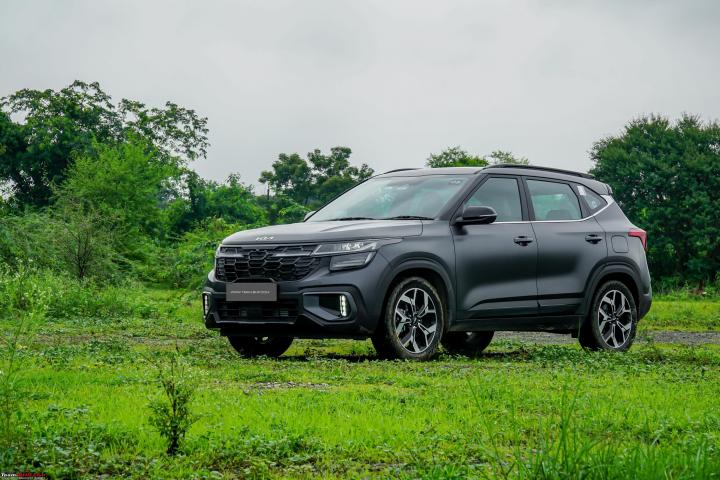






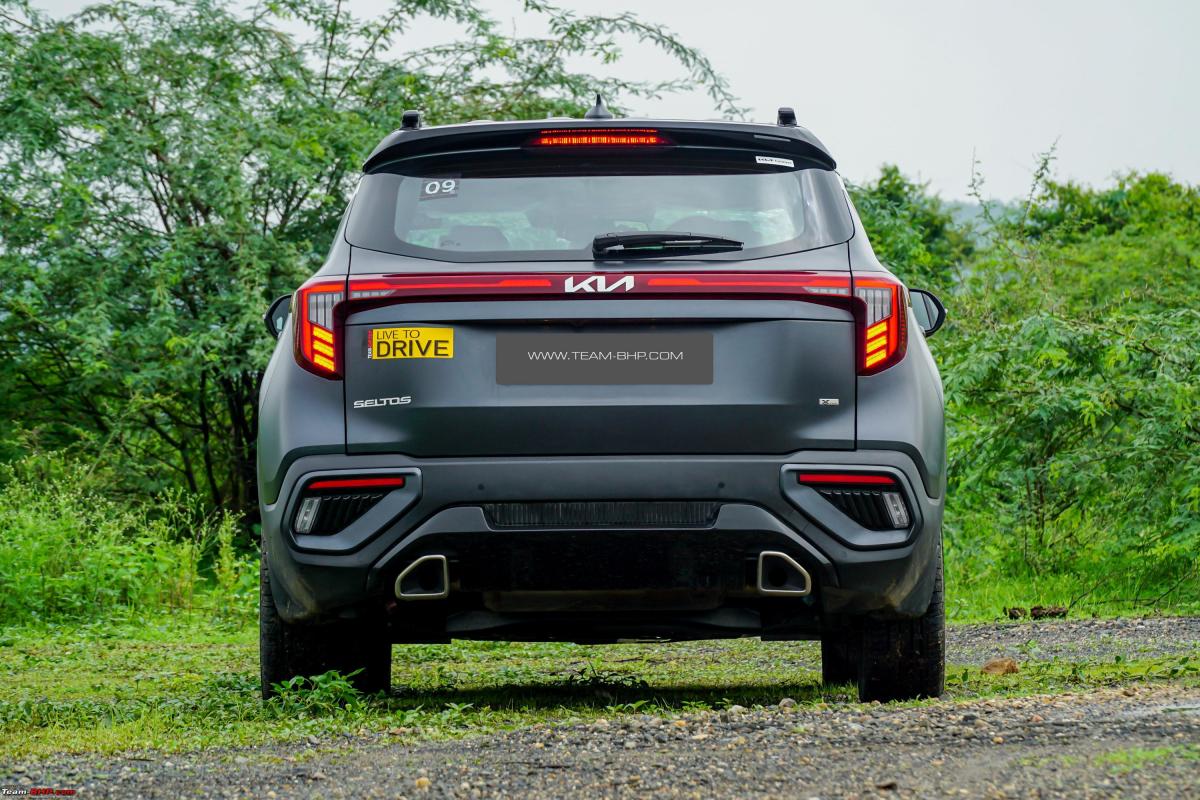
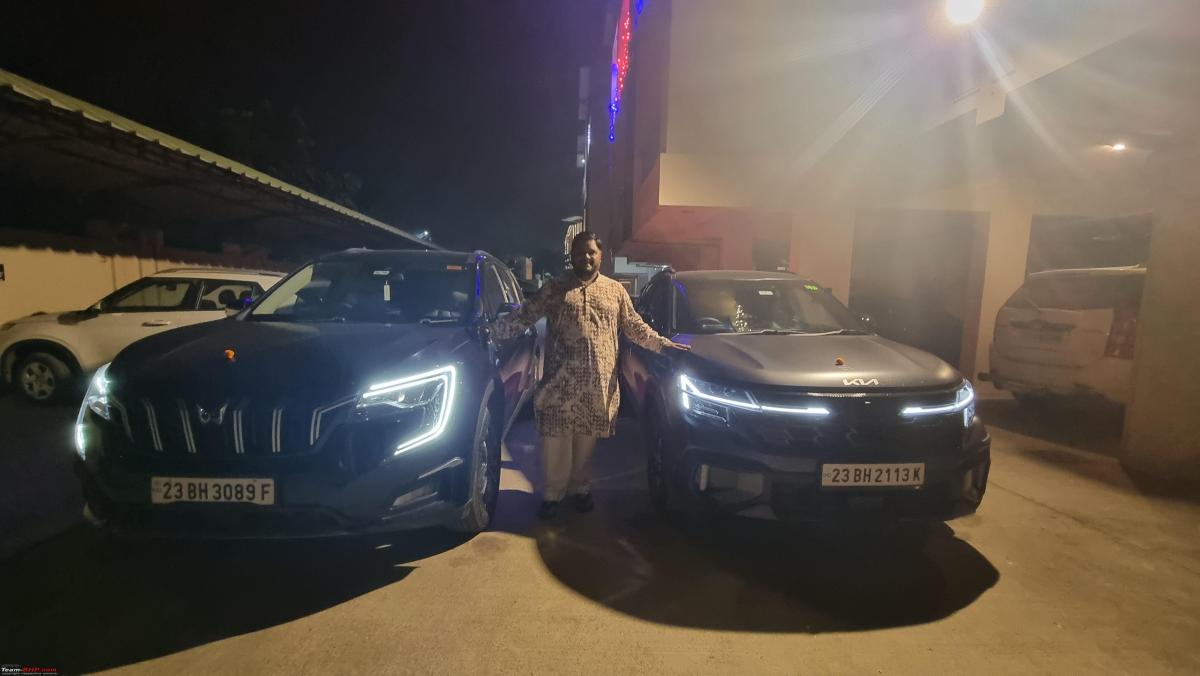
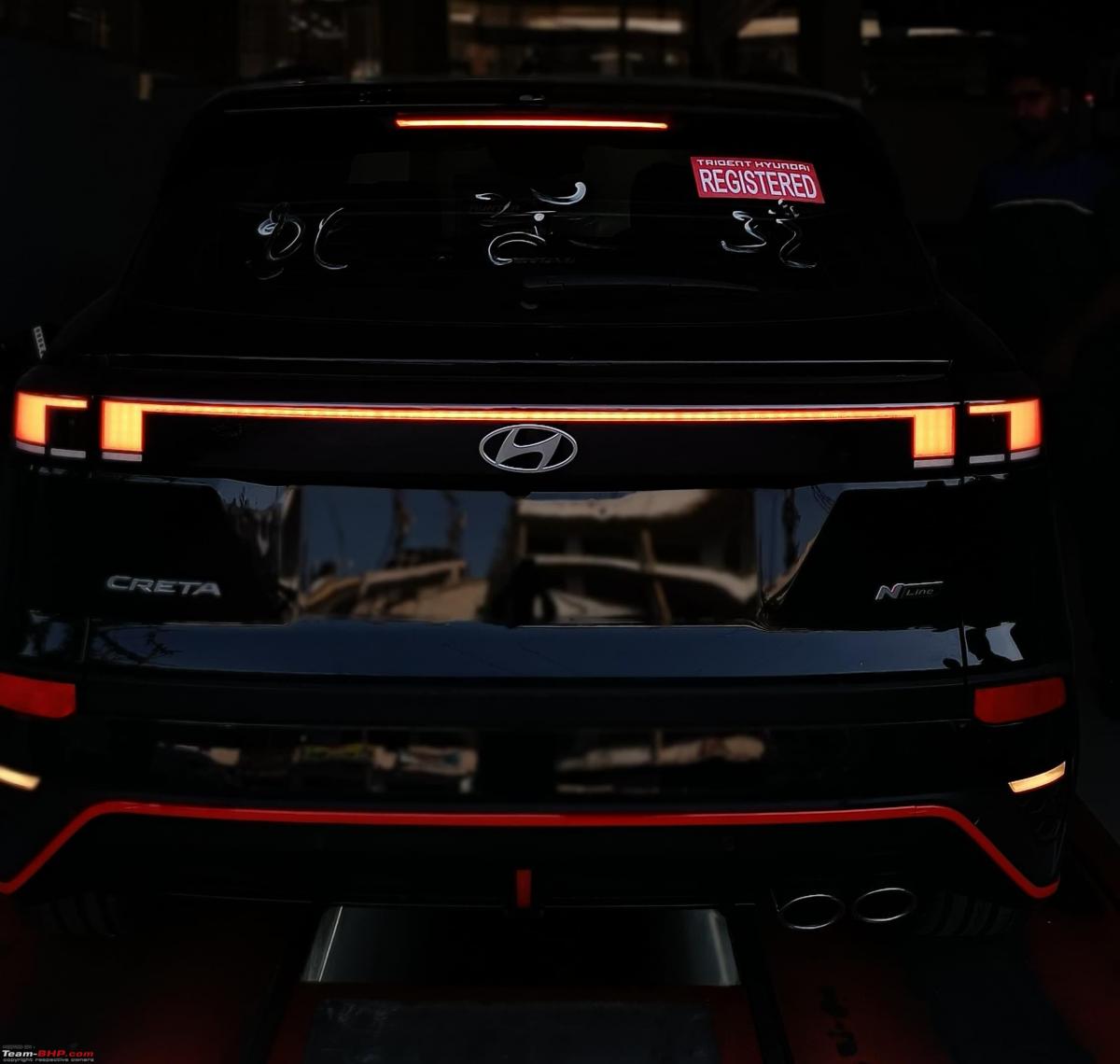
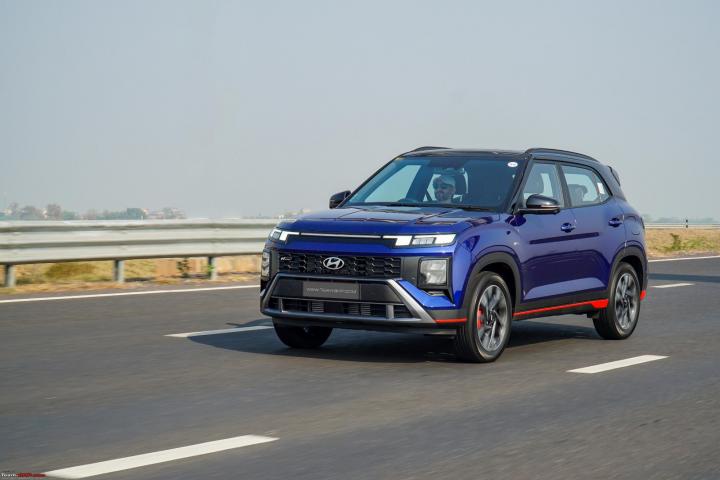
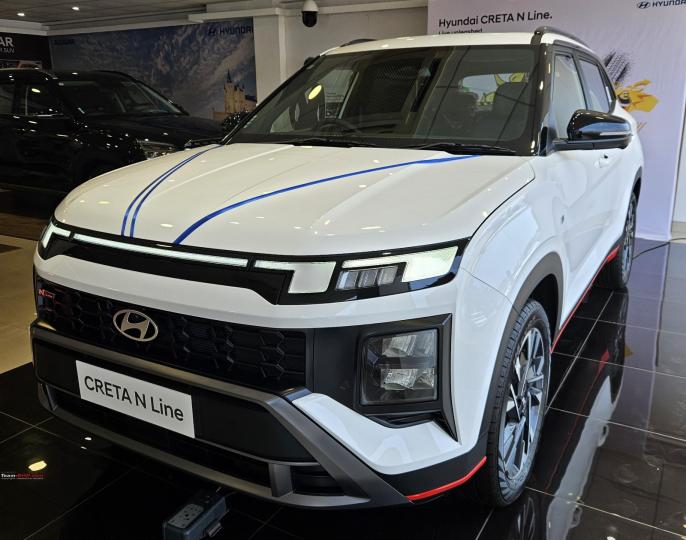
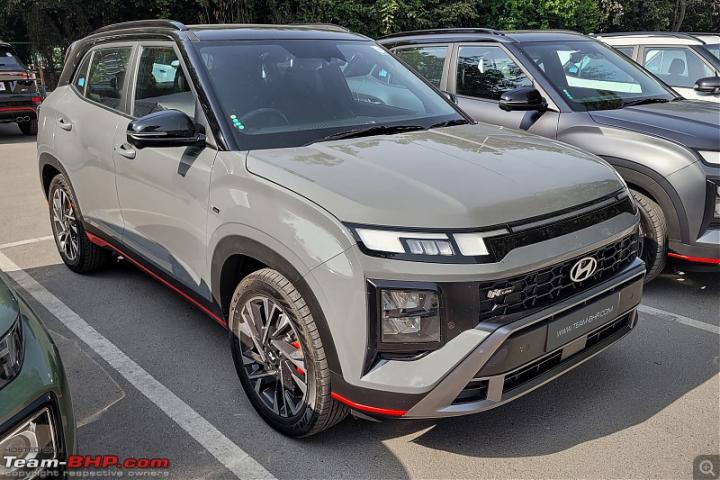
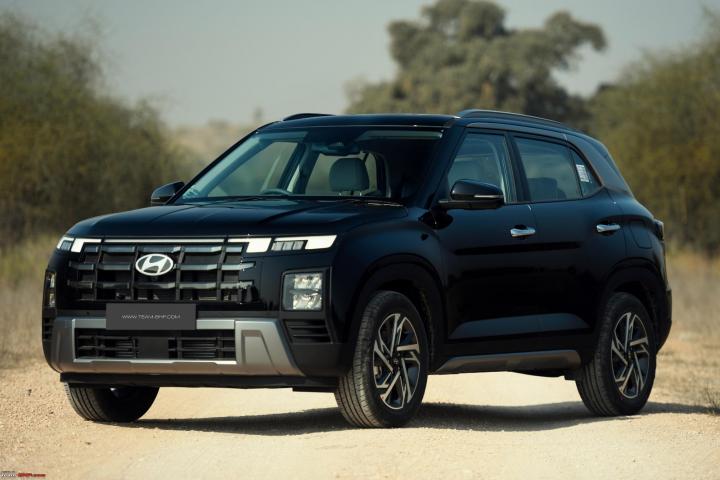














.jpg)
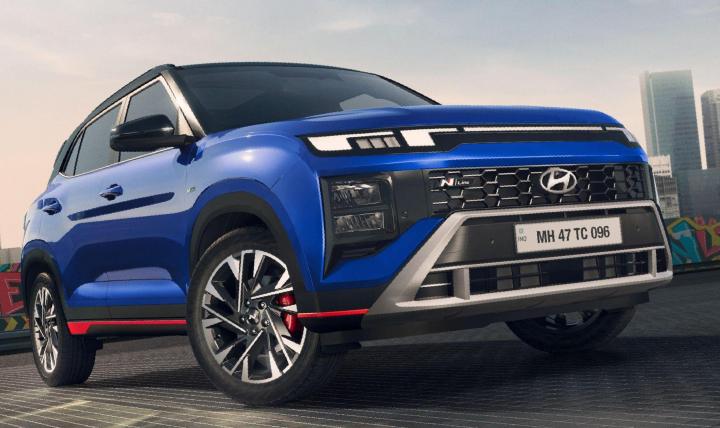





_1.jpg)
